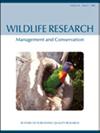Controlling feral ruminants to reduce greenhouse gas emissions: a case study of buffalo in northern Australia
IF 1.6
3区 生物学
Q3 ECOLOGY
引用次数: 0
Abstract
ABSTRACT Context. The bourgeoning carbon economy is creating novel ways to incentivise conservation management activities that have the co-benefits of reducing greenhouse gas (GHG) emissions and social inequality. Aims. To estimate the monetary value of carbon credits that landowners could generate by reducing ecologically destructive feral populations of the Asian water buffalo (Bubalus bubalis) in northern Australia. Methods. First, we estimated buffalo enteric emissions based on the population structure of feral buffalo in northern Australia, and discounted the reduction of fire emissions due to the consumption of grassy fuel by feral buffalo. We then predicted the change in buffalo population size across the South Alligator River region of Kakadu National Park under four buffalo management scenarios: (1) no buffalo control; (2) low-intensity buffalo control; (3) moderate-intensity buffalo control; and (4) high-intensity buffalo control. We quantified the reduction of GHG emissions under the three buffalo control scenarios, relative to the scenario of no buffalo control, while discounting the GHG emissions that directly result from buffalo control actions (e.g. helicopter emissions). Key results. All three buffalo control scenarios substantially reduced the estimated GHG emissions that would otherwise have been produced. The low-intensity buffalo control scenario was predicted to abate 790 513 t CO2-e over the 20-year simulation, worth USD15 076 085 (or USD753 804 year−1). Our high-intensity buffalo control scenario had the greatest reduction in GHG emissions, with a total net abatement of 913 231 t CO2-e, worth USD17 176 437 (or USD858 822 year−1). Conclusions. The potential value of carbon credits generated by controlling feral buffalo populations in northern Australian savannas far exceeds the management costs. Implications. The management of feral ruminants could be incentivised by the generation of carbon credits. Such management could simultaneously avoid GHG emissions, generate income for landowners and offer significant ecological benefits.控制野生反刍动物以减少温室气体排放:澳大利亚北部水牛的案例研究
蓬勃发展的碳经济正在创造新的方式来激励保护管理活动,这些活动具有减少温室气体(GHG)排放和社会不平等的共同利益。目的估计土地所有者通过减少澳大利亚北部亚洲水牛(Bubalus bubalis)的生态破坏性野生种群而产生的碳信用的货币价值。方法首先,根据澳大利亚北部野牛种群结构估算野牛肠道排放,并贴现野牛消耗草类燃料导致的火灾排放减少。在4种水牛管理情景下,对Kakadu国家公园南鳄鱼河地区水牛种群规模的变化进行了预测:(1)不控制水牛;(2)低强度控制水牛;(3)适度控制水牛;(4)高强度的水牛控制。我们量化了三种水牛控制情景下的温室气体排放量减少,相对于不控制水牛的情景,同时贴现了水牛控制行动直接导致的温室气体排放(如直升机排放)。所有三种水牛控制方案都大大减少了本应产生的温室气体排放量。低强度水牛控制情景预计在20年模拟期间减少790513tCO2-e,价值15076085美元(或753804美元)。我们的高强度水牛控制情景减少的温室气体排放量最大,净减排总量为913231tCO2-e,价值17176437美元(或858822美元)。结论控制澳大利亚北部草原野生水牛种群产生的碳信用的潜在价值远远超过管理成本。产生碳信用可以激励野生反刍动物的管理。这种管理可以同时避免温室气体排放,为土地所有者创造收入,并提供显著的生态效益。
本文章由计算机程序翻译,如有差异,请以英文原文为准。
求助全文
约1分钟内获得全文
求助全文
来源期刊

Wildlife Research
生物-动物学
CiteScore
4.30
自引率
15.80%
发文量
56
审稿时长
3 months
期刊介绍:
Wildlife Research represents an international forum for the publication of research and debate on the ecology, management and conservation of wild animals in natural and modified habitats. The journal combines basic research in wildlife ecology with advances in science-based management practice. Subject areas include: applied ecology; conservation biology; ecosystem management; management of over-abundant, pest and invasive species; global change and wildlife management; diseases and their impacts on wildlife populations; human dimensions of management and conservation; assessing management outcomes; and the implications of wildlife research for policy development. Readers can expect a range of papers covering well-structured field studies, manipulative experiments, and analytical and modelling studies. All articles aim to improve the practice of wildlife management and contribute conceptual advances to our knowledge and understanding of wildlife ecology.
Wildlife Research is a vital resource for wildlife scientists, students and managers, applied ecologists, conservation biologists, environmental consultants and NGOs and government policy advisors.
Wildlife Research is published with the endorsement of the Commonwealth Scientific and Industrial Research Organisation (CSIRO) and the Australian Academy of Science.
 求助内容:
求助内容: 应助结果提醒方式:
应助结果提醒方式:


